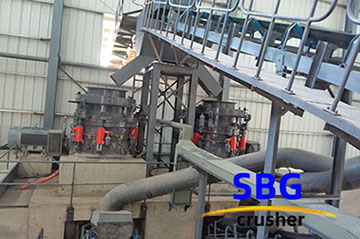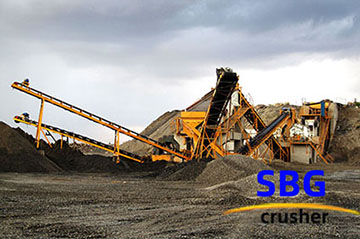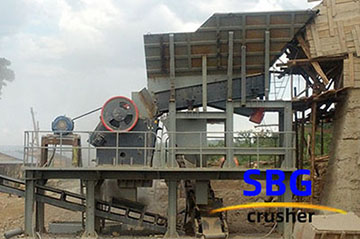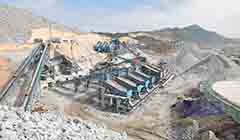 [PDF]
[PDF]gold occurs as tiny inclusions or submicroscopic gold and are therefore refractory. Silver-rich ores and copper sulfide ores: Silver-rich ores and copper sulfide ores are often free-milling, but when the silver grade is high (>10 g/t) and/or the gold is present as electrum, the processing may need to be modified. The greater reactivity of silver
 سؤال
سؤال 32;Recovering gold from sulfide refractory gold ore has been an important guarantee for the sustainable development of gold industry, while there are many challenges in the treatment of sulfide refractory gold ore, such as environmental pollution and low gold recovery.
32;Recovering gold from sulfide refractory gold ore has been an important guarantee for the sustainable development of gold industry, while there are many challenges in the treatment of sulfide refractory gold ore, such as environmental pollution and low gold recovery.
 سؤال
سؤال (PDF) FLOWSHEET ASSESSMENT TO RECOVER MOREA typical flowsheet for processing refractory gold oreRefractory Gold Ore Treatment Methods-MineralProcessing of refractory gold ores-ScienceDirectArsenic release through refractory gold ore processing.• &
(PDF) FLOWSHEET ASSESSMENT TO RECOVER MOREA typical flowsheet for processing refractory gold oreRefractory Gold Ore Treatment Methods-MineralProcessing of refractory gold ores-ScienceDirectArsenic release through refractory gold ore processing.• & سؤال
سؤال 32;Ammoniacal thiosulfate leaching of refractory oxide gold ore was investigated. According to X-ray fluorescence and fire assay analyses, the ore contained about 33.01 wt% Si, 8.53 wt% Al, 7.26 wt% K, 3.00 wt% Fe, and 2.80 ppm Au. Moreover, X-ray diffraction analysis and mineralogical studies using polished thin sections showed
32;Ammoniacal thiosulfate leaching of refractory oxide gold ore was investigated. According to X-ray fluorescence and fire assay analyses, the ore contained about 33.01 wt% Si, 8.53 wt% Al, 7.26 wt% K, 3.00 wt% Fe, and 2.80 ppm Au. Moreover, X-ray diffraction analysis and mineralogical studies using polished thin sections showed
 سؤال
سؤال
The pretreatment of gold ores before cyanidation is a challenging problem due to the world’s annual huge waste of refractory gold minerals. Generally, the leaching of gold by cyanidation without
 سؤال
سؤال 32;Green non-toxic extracting gold from refractory sulfide gold ore using thiosulfate is an essential guarantee for the sustainable development of the gold industry. However, there are many bottlenecks, including environmental pollution from traditional pretreatment of sulfide gold ore and high consumption of chemical thiosulfate.
32;Green non-toxic extracting gold from refractory sulfide gold ore using thiosulfate is an essential guarantee for the sustainable development of the gold industry. However, there are many bottlenecks, including environmental pollution from traditional pretreatment of sulfide gold ore and high consumption of chemical thiosulfate.
 سؤال
سؤال 32;Refractory is generally defined as the ore thatyields <80 wt.% Au after standard physicochemical leaching conditions [11].Au-refractory ores, in most cases, contain elevated concentrations of arsenic, mainly with the form of arsenian pyrite (FeS 2), arsenopyrite (FeAsS), realgar (As 4 S 4), and orpiment (As 2 S 3).The entire
32;Refractory is generally defined as the ore thatyields <80 wt.% Au after standard physicochemical leaching conditions [11].Au-refractory ores, in most cases, contain elevated concentrations of arsenic, mainly with the form of arsenian pyrite (FeS 2), arsenopyrite (FeAsS), realgar (As 4 S 4), and orpiment (As 2 S 3).The entire
 سؤال
سؤال 32;However, the gold recovery was 80 per cent compared to the Kalgoorlie gold mines of 96-98 per cent. Flotation, roasting and cyanidation. The run-of-mine ore was crushed in a McCully gyratory crusher, two Symons standard cone secondary crushers and oversize re-crushed in a Symons short-head tertiary crusher before feeding to the
32;However, the gold recovery was 80 per cent compared to the Kalgoorlie gold mines of 96-98 per cent. Flotation, roasting and cyanidation. The run-of-mine ore was crushed in a McCully gyratory crusher, two Symons standard cone secondary crushers and oversize re-crushed in a Symons short-head tertiary crusher before feeding to the
 سؤال
سؤال 32;1. Introduction. Gold is a precious strategic metal that is driving everyday life, the electronics industry, and the global economy (Zhan et al., 2021; Zhang et al., 2022a, Zhang et al., 2022b, Zhang et al., 2022c, Zhang et al., 2022).However, with the depletion of high-quality gold ore, refractory gold resources (gold recovery efficiency rate of <50%
32;1. Introduction. Gold is a precious strategic metal that is driving everyday life, the electronics industry, and the global economy (Zhan et al., 2021; Zhang et al., 2022a, Zhang et al., 2022b, Zhang et al., 2022c, Zhang et al., 2022).However, with the depletion of high-quality gold ore, refractory gold resources (gold recovery efficiency rate of <50%
 سؤال
سؤال [PDF]
[PDF]African gold plant. These figures are not a standard but reflect the nature of the ore and the design basis for a particular situation. The ore is first reduced in size (typically 80% passing 75& سؤال
سؤال
 32;The samples used in the experiments were prepared from the one-quarter fraction of 1–2 cm sized ores which were separated as stock during the crushing of original samples taken from the deposit in an amount of 80–90 kg for cyanide leaching process by MTA.After crushing in a cone crusher to about 0.5 cm, the samples were ground to 2–3
32;The samples used in the experiments were prepared from the one-quarter fraction of 1–2 cm sized ores which were separated as stock during the crushing of original samples taken from the deposit in an amount of 80–90 kg for cyanide leaching process by MTA.After crushing in a cone crusher to about 0.5 cm, the samples were ground to 2–3
 سؤال
سؤال 32;A novel pretreatment method for refractory gold ore using ultrasound-activated persulfate was developed to overcome the low extraction efficiency of gold in the leaching process. The feasibility of the pretreatment method was verified primarily by EPR (Electron paramagnetic resonance) and pre-oxidation tests. The free radicals generated
32;A novel pretreatment method for refractory gold ore using ultrasound-activated persulfate was developed to overcome the low extraction efficiency of gold in the leaching process. The feasibility of the pretreatment method was verified primarily by EPR (Electron paramagnetic resonance) and pre-oxidation tests. The free radicals generated
 سؤال
سؤال
OLESI 8 Orbital Jaw Rock Crusher mining gold silver. The OLESI line of crushers is a primary Jaw style Crusher. Utilizing only one moving part this machine is simple but effective. It simplicity makes it far more robust and lighter than comparable size Jaw crusher. Goldbelt global has been producing and refining this machine since 2012 and it
 سؤال
سؤال
The use of thiosulfate to extract gold from refractory ores is promising because of its non-toxicity and high selectivity. Sulfide minerals (i.e., pyrite, arsenopyrite, chalcopyrite), major gold carriers in refractory gold ores, however, hinder gold extraction due to the high consumption of a lixiviant. In this study, a new method to improve
 سؤال
سؤال 32;Double refractory gold ore was sequentially pretreated to oxidize sulfides by thermophilic archaeon Acidianus brierleyi and then to decompose carbonaceous matters using the cell-free spent medium (CFSM) from white-rot fungus Phanerochaete chrysosporium.The pretreatment by A. brierleyi significantly improved the gold recovery
32;Double refractory gold ore was sequentially pretreated to oxidize sulfides by thermophilic archaeon Acidianus brierleyi and then to decompose carbonaceous matters using the cell-free spent medium (CFSM) from white-rot fungus Phanerochaete chrysosporium.The pretreatment by A. brierleyi significantly improved the gold recovery
 سؤال
سؤال 32;1. Introduction. The depletion of large oxidized‑gold deposits triggered the processing of refractory ores, where the precious metals are associated with sulfides and other compounds of base metals, antimony or arsenic (Jha and Kramer, 1984).There are several alternatives for the treatment of refractory minerals, which have been studied for
32;1. Introduction. The depletion of large oxidized‑gold deposits triggered the processing of refractory ores, where the precious metals are associated with sulfides and other compounds of base metals, antimony or arsenic (Jha and Kramer, 1984).There are several alternatives for the treatment of refractory minerals, which have been studied for
 سؤال
سؤال 32;Publisher Summary. Circulating fluidized-bed (CFB) technology has been successfully applied to the roasting of refractory gold ores and concentrates on both pilot plants (200, 350 and 700mm furnace inner diameters) and commercial CFB roasting plants. The CFB provides conditions for enhanced heat and mass transfer, supporting nearly
32;Publisher Summary. Circulating fluidized-bed (CFB) technology has been successfully applied to the roasting of refractory gold ores and concentrates on both pilot plants (200, 350 and 700mm furnace inner diameters) and commercial CFB roasting plants. The CFB provides conditions for enhanced heat and mass transfer, supporting nearly
 سؤال
سؤال 32;The application of pressure oxidation (POX) followed by thiosulfate gold leaching is an efficient method used to extract gold from double refractory gold ores containing both sulfide and carbonaceous matter. This process is expected to result in high gold recovery rates, as it liberates gold from sulfides and eliminates the preg-robbing
32;The application of pressure oxidation (POX) followed by thiosulfate gold leaching is an efficient method used to extract gold from double refractory gold ores containing both sulfide and carbonaceous matter. This process is expected to result in high gold recovery rates, as it liberates gold from sulfides and eliminates the preg-robbing
 سؤال
سؤال [PDF]
[PDF]The problem of the refractory nature of gold bearing arsenide ores is described. The basic principle, characteristics and application of pretreatment technique of arsenic-bearing gold ores are presented in
 سؤال
سؤال 32;Crushing starts with the primary 42” x 65” gyratory crusher and fed to the Nordberg MP800 secondary crusher where it is crushed to 80% passing 3/4 inches. After the material is crushed it is stockpiled for feed into either grinding train. The gold ore is double-refractory. First, the gold is locked in sulfide mineral particles that must
32;Crushing starts with the primary 42” x 65” gyratory crusher and fed to the Nordberg MP800 secondary crusher where it is crushed to 80% passing 3/4 inches. After the material is crushed it is stockpiled for feed into either grinding train. The gold ore is double-refractory. First, the gold is locked in sulfide mineral particles that must
 سؤال
سؤال [PDF]
[PDF]It considers the diverse processing approach (route)neededto render refractory gold ores amenable to cyanidation. Directions for future research in processing refractory gold ores has been stated.
 سؤال
سؤال 32;The depletion of readily amenable gold ores and discovery of complex deposits inspire knowledge improvement and search of commercially effective technique in extracting gold from refractory gold
32;The depletion of readily amenable gold ores and discovery of complex deposits inspire knowledge improvement and search of commercially effective technique in extracting gold from refractory gold
 سؤال
سؤال 32;Refractory gold ore is usually affected by the associated carbonaceous matter through the preg-robbing effect, which is eliminated by oxidation roasting, followed by leaching, to achieve a satisfactory gold leaching efficiency. Roasting–leaching experiments, pore structure measurements, scanning electron microscopy (SEM), and X-ray diffraction
32;Refractory gold ore is usually affected by the associated carbonaceous matter through the preg-robbing effect, which is eliminated by oxidation roasting, followed by leaching, to achieve a satisfactory gold leaching efficiency. Roasting–leaching experiments, pore structure measurements, scanning electron microscopy (SEM), and X-ray diffraction
 سؤال
سؤال [PDF]
[PDF]Gold deportment studies, using diagnostic leaching, showed that after cyanidation of the flotation concentrates and bio-oxidation products, ~79 and ~77 wt.% of gold in DC and AC were, respectively, unextractable. On the other hand, ~31 wt.% and ~78 wt.% of gold in JF and JC were unrecovered by cyanide leaching.
 سؤال
سؤال 32;Abstract. Ammoniacal thiosulfate leaching of refractory oxide gold ore was investigated. According to X-ray fluorescence and fire assay analyses, the ore contained about 33.01 wt% Si, 8.53 wt% Al, 7.26 wt% K, 3.00 wt% Fe, and 2.80 ppm Au. Moreover, X-ray diffraction analysis and mineralogical studies using polished thin
32;Abstract. Ammoniacal thiosulfate leaching of refractory oxide gold ore was investigated. According to X-ray fluorescence and fire assay analyses, the ore contained about 33.01 wt% Si, 8.53 wt% Al, 7.26 wt% K, 3.00 wt% Fe, and 2.80 ppm Au. Moreover, X-ray diffraction analysis and mineralogical studies using polished thin
 سؤال
سؤال 32;Carbon–arsenic-bearing gold ore is a typical complex refractory gold resource. Traditionally, xanthate was often used as a flotation agent to separate gold minerals. But, in this paper, in order to reduce the cost of the agent, kerosene was used as an auxiliary collector, and the gold grade and recovery rate were increased by about 10
32;Carbon–arsenic-bearing gold ore is a typical complex refractory gold resource. Traditionally, xanthate was often used as a flotation agent to separate gold minerals. But, in this paper, in order to reduce the cost of the agent, kerosene was used as an auxiliary collector, and the gold grade and recovery rate were increased by about 10
 سؤال
سؤال 32;Refractory gold bearing sulfide mineralization is spatially associated with the carbonaceous matter rich meta-sedimentary rocks of the Proterozoic South Purulia Shear Zone (SPSZ).The carbon rich layers occurring as black, continuous laminae are the metamorphosed derivatives of carbonaceous matter, which were originally present in the
32;Refractory gold bearing sulfide mineralization is spatially associated with the carbonaceous matter rich meta-sedimentary rocks of the Proterozoic South Purulia Shear Zone (SPSZ).The carbon rich layers occurring as black, continuous laminae are the metamorphosed derivatives of carbonaceous matter, which were originally present in the
 سؤال
سؤال 32;Currently, there is a lack of research on column bio-oxidation for low-grade refractory gold ore with high arsenic and sulfur content. Therefore, it is essential and significative to investigate column bio-oxidation for this type of gold ore.
32;Currently, there is a lack of research on column bio-oxidation for low-grade refractory gold ore with high arsenic and sulfur content. Therefore, it is essential and significative to investigate column bio-oxidation for this type of gold ore.
 سؤال
سؤال 32;The use of thiosulfate to extract gold from refractory ores is promising because of its non-toxicity and high selectivity. Sulfide minerals (i.e., pyrite, arsenopyrite, chalcopyrite), major gold carriers in refractory gold ores, however, hinder gold extraction due to the high consumption of a lixiviant. In this study, a new method to improve gold
32;The use of thiosulfate to extract gold from refractory ores is promising because of its non-toxicity and high selectivity. Sulfide minerals (i.e., pyrite, arsenopyrite, chalcopyrite), major gold carriers in refractory gold ores, however, hinder gold extraction due to the high consumption of a lixiviant. In this study, a new method to improve gold
 سؤال
سؤال
The carbonaceous material can adsorb gold, an effect known as preg-robbing, from the solution similar to activated carbon, which is used in the purification and concentration of gold from cyanide solutions for the subsequent desorption and recovery of gold. The ability of the carbonaceous material to adsorb aurocyanide complex from the solution
 سؤال
سؤال

آلة تكسير الحصى بقدرة 45-1200 طن/ساعة بسعر مناسب، يرجى الاتصال بنا إذا لزم الأمر.
احصل على عرض أسعار